Digital audio mixers are portable, feature a ton of inputs and outputs, and have built-in effects, making them a great addition to your studio and live setup.
However, with so many options and features available, finding a digital mixer can be a challenge.
Unless you know exactly what you need, aren’t committed to a brand, or are narrowing your search down due to budget, there are simply too many digital mixers to choose from!
Best Digital Mixing Boards in 2025
1. Allen & Heath SQ-5

The SQ-5 digital mixer is one of the best audio mixers available when it comes to portability. It’s rack-mountable, versatile, and easy to install in venues and small home studios.
It has 48 channels, 16 great onboard mic preamps, 12 XLRs, and 2 main outputs.
It has dedicated physical controls, 8 assignable softkeys, 17 motorized faders with 6 fader layers, and a SLink port for remote audio and I/O expansion.
Other features of the Allen & Heath SQ-5 include eight stereo FX engines including delay, reverb, chorus, flanger, phaser, EQ, and compressor, and a built-in USB audio interface for multitrack recording directly to a computer or USB drive with 24-bit/96kHz resolution and less than 0.7ms latency.
The SQ MixPad app, available for Windows, Mac, iOS, and Android, provides a remote control for the main mixing functions. SQ4You also allows performers to control their monitor mixes with their mobile devices.
2. Behringer X32 Digital Mixer

This mixer is perfect for aspiring musicians and producers, offering a great balance of affordability and top-notch features.
The Behringer X32 digital mixer offers a variety of options to help you create and tweak your sound.
With 32 gain-programmable mic preamps and 25 motorized faders, you have complete control over your mix. Plus, you can add various effects using the virtual FX rack.
The weight can be an issue, though. Weighing in at 63 pounds, it’s not exactly portable.
You’ll need to consider additional space to accommodate this mixer. It also has a lot of features that beginners might find difficult to understand at first. But don’t worry, with time and practice, you’ll get the hang of it.
Overall, I highly recommend the Behringer X32 digital mixer for its versatility and excellent sound quality. If you’re looking for a mixer that can handle large projects and offers a variety of options, this is the perfect choice.
3. Yamaha TF5 32-Channel Digital Mixing Console

The Yamaha TF5 is built for large-scale applications with its impressive input capacity and fader count.
Featuring 33 motorized faders (32 channels + 1 master) and 48 input mixing channels (40 mono + 2 stereo + 2 returns), this console addresses the complex needs of live sound environments, from concerts to corporate events.
Featuring 32 analog XLR/TRS combo mic/line inputs and additional RCA inputs, the TF5 ensures comprehensive connectivity options.
With 20 Aux buses and 8 DCA groups with rollouts, it supports complex audio routing and mixing strategies, giving sound engineers extensive control over their live sound mixes.
Yamaha’s commitment to supporting the creativity of sound engineers is evident in the design of the TF5, which emphasizes intuitive operation and a user-friendly interface.
This approach allows for limitless creativity, making the console accessible to engineers of all skill levels.
The Yamaha TF5 32-channel digital mixing console stands out for its ability to easily handle demanding live sound environments.
Its high input capacity, extensive control features, and intuitive design combine to make it the best choice for sound engineers looking for a reliable and versatile console for larger applications.
While size may be a consideration for those with mobile needs, its performance and flexibility meet the high expectations associated with Yamaha’s professional audio gear.
4. Midas M32R LIVE
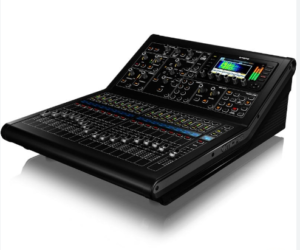
The Midas M32R LIVE digital mixer is a highly portable and compact version of the original M32 while maintaining both outstanding audio quality and impressive computing power.
It’s the perfect size for small venues and jam sessions.
The Midas M32R Live features 16 state-of-the-art MIDAS mic preamps, 8 XLR outputs, 8 DCAs, and 6 mute groups.
With the Midas M32R Live, you get a virtual rack of over 50 world-class effects processors, including emulations of classics like EQs, dynamics, gates, compressors, LA-2As, Fairchild 670 compressors, and Pultec equalizers.
The Midas M32R Live’s remote control system allows you to operate the digital mixer via your computer and smart devices with a remote control app.
Using your mobile device’s screen helps to offset the small size of the M32R Live’s GUI screen.
The Midas M32R Live features a built-in audio interface that provides 32 channels for playback and recording to SD cards or a computer DAW. Multitrack recording, sound check, and backtrack playback are possible.
The Midas M32R Live’s cue list function allows you to recall console layouts and store up to 100 scenes or 100 snippets for specific setups for live performances.
5. QSC TouchMix 8 Compact Digital Mixer

QSC TouchMix 8 Compact Digital Mixer The QSC TouchMix 8 is a powerful, compact mixer ideal for live performances.
It offers a range of audio optimization tools, including 4-band parametric equalization, dynamics processing, and digital effects.
This comprehensive feature set is ideal for live sound, allowing you to quickly adjust to the acoustics of the venue.
The mixer’s channel presets, designed by experienced sound engineers, allow you to quickly set up your live sound requirements.
The Effects Wizard simplifies effect selection and assignment, while the Gain Wizard prevents input clipping.
TouchMix also boasts a library of Mixer Scenes, allowing you to save parameters internally or to a USB drive.
The intuitive 7-inch full-color display, rotary encoders, and buttons can operate on their own, without the need for an external display.
The Remote Control app for iOS devices also enhances parameter control via wireless connectivity. Recording directly to a USB hard drive in high-quality formats makes post-processing tracks a breeze.
With its protective carrying case, TouchMix 8 is a versatile and convenient solution for live performance.
6. Soundcraft Ui24R
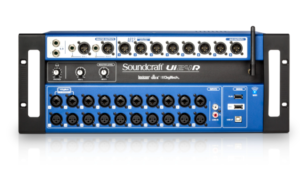
The Soundcraft Ui24R is a 24-channel rack-mount digital remote-controlled mixer.
It offers 20 inputs, 10 combo XLR/jack, 10 XLR dedicated, and 1 dual RCA stereo. Using the built-in audio interface, you can record all 22 inputs and the stereo mix to a USB drive or DAW.
Soundcraft makes this easy by including Ableton Live 10 Lite with every Ui series mixer.
The Soundcraft Ui24R digital mixer offers three dedicated effects buses with world-class Lexicon effects such as reverb, delay, and chorus.
Each channel includes dbx compression, dbx AFS2 automatic feedback suppression, de-essing, gate, and real-time frequency analyzer. The first two hi-Z inputs feature DigitTech guitar amp modeling.
All parameters of the effects are fully customizable.
The Ui24R features dual-band Wi-Fi, allowing you to control the digital mixer from any device that has access to a browser.
Use your computer or mobile device to control live mixing, effects, and busses, and have each band member monitor the mix and volume.
Up to 10 devices can be connected to the Ui24R simultaneously via Wi-Fi or Ethernet. Overall, the Soundcraft Ui24R is a compact digital mixer with a full remote that can be used as a stage box.
7. Mackie DL32S Digital Rack Mixer

We have been using the Mackie DL32S digital rack mixer and it has been a game changer. With 32 channels of capacity and a Built-Like-A-Tank design, it’s ideal for both small and large-scale gigs.
What sets this mixer apart is its built-in Wi-Fi networking, allowing you to control your mix from anywhere in the room using the Master Fader app.
Note that you’ll need to purchase an external router and iPad separately.
The only downside is that the Master Fader app can be a bit overwhelming for beginners. But once you get used to it, you’ll wonder how you ever lived without it. Try the Mackie DL32S and see for yourself.
The Mackie DL32S is a robust 32-channel digital rack mixer that seamlessly integrates with a 32-in/32-out USB 2.0 audio interface, making it ideal for both live performance and studio recording.
Built-in Wi-Fi networking provides exceptional control via the multi-platform Master Fader app, allowing wireless operation from a variety of devices.
Featuring the legendary Onyx+ mic preamps, the DL32S delivers outstanding sound quality.
Comprehensive output and input channel DSP and four stereo FX processors support a wide range of sound effects and mixing capabilities, delivering the best mix quality in every scenario.
Designed with real-world applications in mind, the DL32S boasts a rugged stage-box design with steel construction and protective rubber corners.
Its compact size and built-in handles make it highly portable and durable, making it ideal for the demanding environments of live performance.
The Mackie DL32S stands out as a powerful and versatile digital rack mixer that meets the needs of professional sound engineers and musicians alike.
High-quality preamps, extensive connectivity, and durable construction combine to make it a reliable choice for achieving superior sound quality in live and studio environments.
It offers advanced mixing features, but the ease of use via the Master Fader app makes it a great investment for those looking to elevate their mixing experience, as it remains accessible to users of all skill levels.
8. Yamaha TF1

The Yamaha TF1 is a compact, easy-to-use digital mixer with TouchFlow operation.
It has 16 combo XLR/jack inputs, 2 RCA stereo inputs, 16 outputs (including 2 main outputs), 16 motorized faders, and a master fader.
It features a physical turn knob, touchscreen, 4 user-defined knobs, and 6 user-defined keys to customize your workflow.
The Yamaha TF1 offers professional presets for Shure, Sennheiser, and Audio-Technica microphones.
Connect a microphone and activate the presets to let the TF1 automatically set the gain, EQ, gate, and compression for your microphone.
You can adjust these and customize your own professional presets if you wish. The TF1 also provides effects for reverb and delay.
The TF1 allows you to record audio in stereo or multitrack to a USB storage device or to your DAW. It makes the Yamaha TF1 a digital mixer for live and studio use, and an audio interface for your computer.
If you need more inputs and faders, you can find the TF3 and TF5 in the TF series, with 24 and 32 channels respectively.
9. Zoom LiveTrak L-20 Digital Mixer
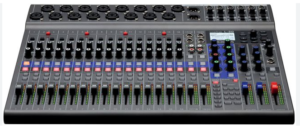
The Zoom LiveTrak L-20 offers creators incredible versatility. Easily mix, monitor, record, and stream complex productions.
With 20 individual audio channels and 22 recording tracks, it’s perfect for bigger, bolder arrangements.
This digital mixer features six individual user-defined monitor mixes, along with dedicated engineer outputs.
It also has 20 built-in effects with adjustable parameters that can be applied to any channel via two dedicated EFX buses. That means you can add a little creativity to your mixes.
In terms of connectivity, the L-20 features a 22-input/4-output USB audio interface mode, allowing you to easily route inputs to your DAW or streaming software.
You can also record to SD cards simultaneously. For wireless control, you will need to use the free iOS app and purchase the optional BTA-1 adapter.
Overall, the Zoom LiveTrak L-20 digital mixer is a solid choice for any artist, producer, or singer-songwriter looking to upgrade their mixing capabilities.
Keep in mind that it may take some time to get used to all of the features, and it’s a bit heavy at 11 pounds.
10. Mackie DL32S

The Mackie DL32S is another stage box-style digital mixer that offers complete remote control from anywhere in your studio or venue.
It features 32 input channels, top-of-the-line Onyx+ mic preamps, and 10 fully assignable XLR outputs. Of the 32 inputs, 16 are XLR, 16 are combo XLR/jack, and 2 are Hi-Z.
The Mackie DL32S features a 32-in/32-out integrated USB audio interface that connects to your computer, allowing you to record multi-tracks in your DAW for later mixing and editing in the studio.
It also supports multi-track recording playback for virtual sound checks or backing tracks.
Built-in Wi-Fi connectivity provides remote control with the intuitive Master Fader control app for iOS, Android, Mac, and Windows.
Up to 20 devices can be connected simultaneously, allowing musicians and engineers to work on individual mixes from the DL32S.
Mackie DL32S effects include reverb, delay, chorus, flanger, tremolo, and parametric EQ, all customizable from the mobile app.
11. Soundcraft Ui24 Digital Mixer
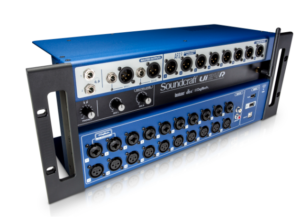
I have been using the Soundcraft Ui24 digital mixer and it has changed my mixing experience. This mixer allows me to control the sound anywhere in the venue using multiple devices.
This means I can collaborate on my mixes without being tied to one place.
The sound quality is excellent thanks to the Studer-designed preamps and Lexicon effects. This mixer adds depth, warmth, and clarity to my mixes.
Plus, the built-in multi-track recording function is really useful, allowing you to record directly to a USB drive or connected computer.
However, there is a learning curve for newcomers to this digital mixer. I initially had a hard time setting it up and controlling it, but I got used to it with time.
I would recommend checking out the online tutorials or talking to fellow musicians who have used this mixer before for guidance.
Also, keep in mind that while wireless control is a great feature, it may not always be perfect, as we’ve seen some users experience Wi-Fi connectivity issues.
Overall, I’m very happy with the Soundcraft Ui24 digital mixer and would highly recommend it to fellow musicians and sound engineers who need great audio quality, flexibility, and wireless control. Just be prepared for a bit of a learning curve and potential connectivity issues.
How to Choose the Best Digital Mixer of 2025?
Digital mixers come in a variety of options and features to suit the needs of every mixing engineer and musician.
You may prefer fewer or more features, or you may prefer a balance between features and budget.
If you’re having trouble finding the right digital mixer for you, check out these essential features before you buy your new studio mixer.
High-Resolution Audio Processing
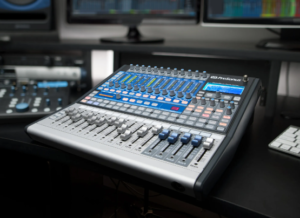
A digital audio mixer that can handle high-resolution audio processing delivers studio-quality sound for recording and live performances.
High-quality audio is a sign of professionalism and is one of the most important things to consider, no matter what project you’re working on.
Channel Count
One of the most important things about a digital mixer is the number of channels. You might think that more is better.
However, if you’re only going to be performing with a microphone and an acoustic guitar, it’s best to look for a digital mixer with fewer channels that has other features instead of spending the extra money on a 40-channel digital mixer.
So, focus on what you think you need or will need in the long run. If you like DJing, one of the best DJ mixers with just a few channels would be a perfect fit.
Remote Control
Remote control may not seem important at first, but it’s a feature that helps you achieve a smooth mixing process.
Remote control is gaining popularity with new digital mixers that have mobile and desktop apps and built-in Wi-Fi.
However, there are also fully remote-controlled digital mixers that don’t have physical faders, knobs, or buttons on their digital mixers and instead allow you to access all the controls directly from the app.
Remote control is very useful when you are walking around a venue doing sound checks while adjusting channel volumes and effects from your laptop or iPad.
But it is also a great feature when recording in a studio, allowing performers to adjust settings from the recording booth.
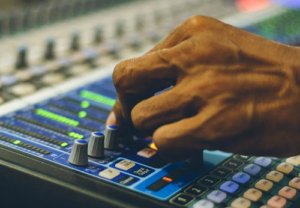
Built-in effects
A variety of effects processors, such as reverb, delay, compression, and EQ, are typically found on digital mixers.
These built-in effects can enhance your mix and reduce the need for external processors. Consider the variety and quality of effects offered by different mixers. Some even allow you to edit effect parameters for customization.
However, for a wider selection or specific sound characteristics, it may be better to use an external effects processor.
Software Integration
If you are connecting your digital mixer to a computer, make sure it includes a digital copy of your DAW or software that controls the digital mixer.
Also, make sure the remote control application is compatible with your mobile device or operating system.
Brands like PreSonus and Yamaha typically include a light version of a DAW with their audio hardware. If you don’t have a DAW or software on your computer, check for software integration.
Portability
The last thing to consider is portability. As mentioned earlier, one of the best things about digital mixers is that you can pack all the power of a top audio mixer into a small, portable device.
Depending on how many channels you need, you can find palm-sized mixers like the Zoom PodTrak P4, which weighs just 0.64 pounds!
Their portability allows you to take your digital mixer with all of your pre-stored scenes to any location, studio, or outdoor live venue.
FAQ
What is a mixing console, what is it used for, and who invented it?
A mixing console is a device that combines audio signals. It is used to adjust and mix sound in music, broadcasting, and live events. It was invented in 1928 in Germany by C.L. Winkler and A.H. Pfannkuch.
Depending on the country you live in, a mixing board is often called an audio console, audio console, soundboard, audio table, sound table, soundboard, mixing board, audio mixer, sound mixer, audio mixer, and sound mixer.
What are the different types of mixing consoles?
There are several types of mixing consoles, including analog, digital, hybrid, amplified, rack-mounted, and DJ controllers.
Some include USB ports for audio playback and recording and Bluetooth connectivity for streaming music from other devices.
Each type of audio desk offers different features and adapts to a variety of environments, from studios to live events. Depending on the site and the technical needs of the user.
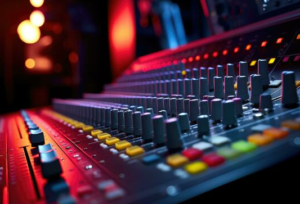
What is the difference between a digital mixer and a digital audio interface (DAW controller)?
A digital audio interface transfers audio signals to and captures audio signals from a computer, while a digital mixer primarily processes and mixes audio signals.
A DAW controller, on the other hand, controls the functions of a digital audio workstation.
Do I need an audio interface if I have a digital mixer?
You don’t necessarily need one. Many digital mixers have built-in audio interfaces. If your digital mixer doesn’t have an audio interface, you may need one to connect it to your computer.
What is the difference between a mixer and a DJ controller?
A mixer is a more versatile type of equipment than a DJ controller.
A mixing console is used by a sound engineer technician or sound engineer to adjust the EQ, mix, and adjust the volume of the microphone output from the speakers, while a DJ controller is used by a DJ to mix live music.
A common question that many people I know often ask is what is the name of the mixer that a DJ uses? This is often called a DJ controller or DJ mixer.
A DJ controller is also a mixer, but it is only used to switch music. Therefore, it is not suitable for a live event sound system.
How many channels does a soundboard have?
A small mixer usually has 4 to 8 channels, while a medium-sized mixer has 12 to 18 channels. The best large mixers range from 24 to 48 channels.
The most advanced and complex mixers can have up to 64 or 128 input channels.
Choosing a mixing console with more or fewer channels will depend on the size of the event and the complexity of the sound mix required.
To work comfortably and properly, we always recommend an audio mixer with at least 12 channels.

Which brand of mixing console is best?
There is no one brand that is best for everyone. Choosing an audio console depends on your individual needs. However, the best and most famous brands of mixers worldwide are Yamaha, Soundcraft, and Behringer.
How to choose an audio mixer?
When choosing an audio console, make sure that it comes from a top pro audio brand.
This is the best brand in professional audio. Evaluate the number of channels, technical settings such as equalization, compression, and effects, multitrack recording, or music playback via USB.
It is also important to consider the size of the event and the sound quality you require. Make sure it has the right features for your application and, if possible, test it before you buy.
Which is better, a mixer or a sound interface?
Choosing a mixer or a sound interface depends on your needs. Mixers are ideal for live events and real-time control.
Sound interfaces are preferred for studio recording and music production. Choose according to your needs.
How do I buy a used mixing console?
When buying a used sound console, do some research online at a dealership, check the condition and performance, negotiate the price, and if possible, get the maintenance history.
If you shop carefully, buying a used sound console can be economical.
How do you say mixer in English?
A loudspeaker is called by different names in different countries, such as loudspeaker, loudspeaker, loudspeaker, and loudspeaker.
Just as loudspeakers are called by different names in different countries, such as speaker, horn, or baffle, a mixing console can also be called by different names.
For example, it is called a “mixing console” or an audio mixer.
What are the different parts of a mixing console called?
The core parts of a professional mixer are the main (main output to the speakers), channel (receiving audio), auxiliary (separate send processing), bus (submix output), and FX (sending the channel to the effects).
There is also an EQ for equalizing, a COM for compressing audio, a PFL (Pre-Fader Listen) for listening to individual channels, a LOW-CUT for adjusting the low frequencies, and a CTRL ROOM, which is a copy of MAIN. These are essential functions in an audio console.
How do digital mixers differ from analog mixers?
Digital mixers can implement more functions in digital mixers than analog mixers, such as storing and recalling settings from sessions and remote control, by using digital signal processors.
Another major difference is that you can alternate between channel strips on a single channel fader, allowing you to work with multiple channel strips in a smaller device.
The same goes for auxiliary sends and groups, providing a seamless workflow.
Most digital mixers offer built-in effects and processing that can be sent to channels with a simple button.
This is something that analog mixers require additional hardware to achieve. With digital mixers, you can also use the mixer as an audio interface by connecting it to your computer via USB.
What types of connection options are there and which ones do you need?
The basic types of connections you’ll find are balanced XLR, ¼ TRS, and RCA I/O. It’s common to find USB, Bluetooth, or Ethernet ports for connecting to your computer. Sometimes you’ll find HDMI, SDHC/SDXC, or USB for storage.

How do I set up and configure a digital mixer?
Digital mixers are easy to set up. Simply connect the AC cable, connect your instruments and microphones to the input channels with XLR or ¼ cables, and connect the main output channels to your monitors or PA system.
To connect a digital mixer to your computer, use a USB cable. Typically, you’ll need a USB-B to USB-A cable (USB-C type connections may require a connector).
Turn on the digital mixer, select the channel that will receive audio, adjust the gain, and apply effects. Use the faders to control each parameter. Please refer to your digital mixer’s user manual for specific setup.
Are there any specific brands or models that you recommend?
Some of the trusted brands like MIDAS, Yamaha, Behringer, and Allen & Heath have been developing audio hardware for years.
Choosing one of these digital mixers will give you professional sound quality. These brands are also known for their excellent customer service.
How much do digital mixers cost?
Digital mixers range in price depending on features, brand, and construction materials. You can find them anywhere from $300 to $15,000, and some even cost over $50,000!
For an entry-level digital mixer, you can expect to spend between $1,000 and $2,500. For a mid-level to professional-level digital mixer, you can expect to pay around $2,500 to $3,000.
Are there any additional accessories that you should purchase with your mixer?
If you already have the essential audio gear, such as microphones, instruments, XLR and TRS cables, Wi-Fi and Ethernet routers, and a DAW for recording from your computer, there are no accessories required to get started using a digital mixer.
For rack-mount digital mixers, a rack-mount kit is required, but if you are using it as a desk console mixer, it is not required.
Also read: Best Digital Mixer for Live Performance
